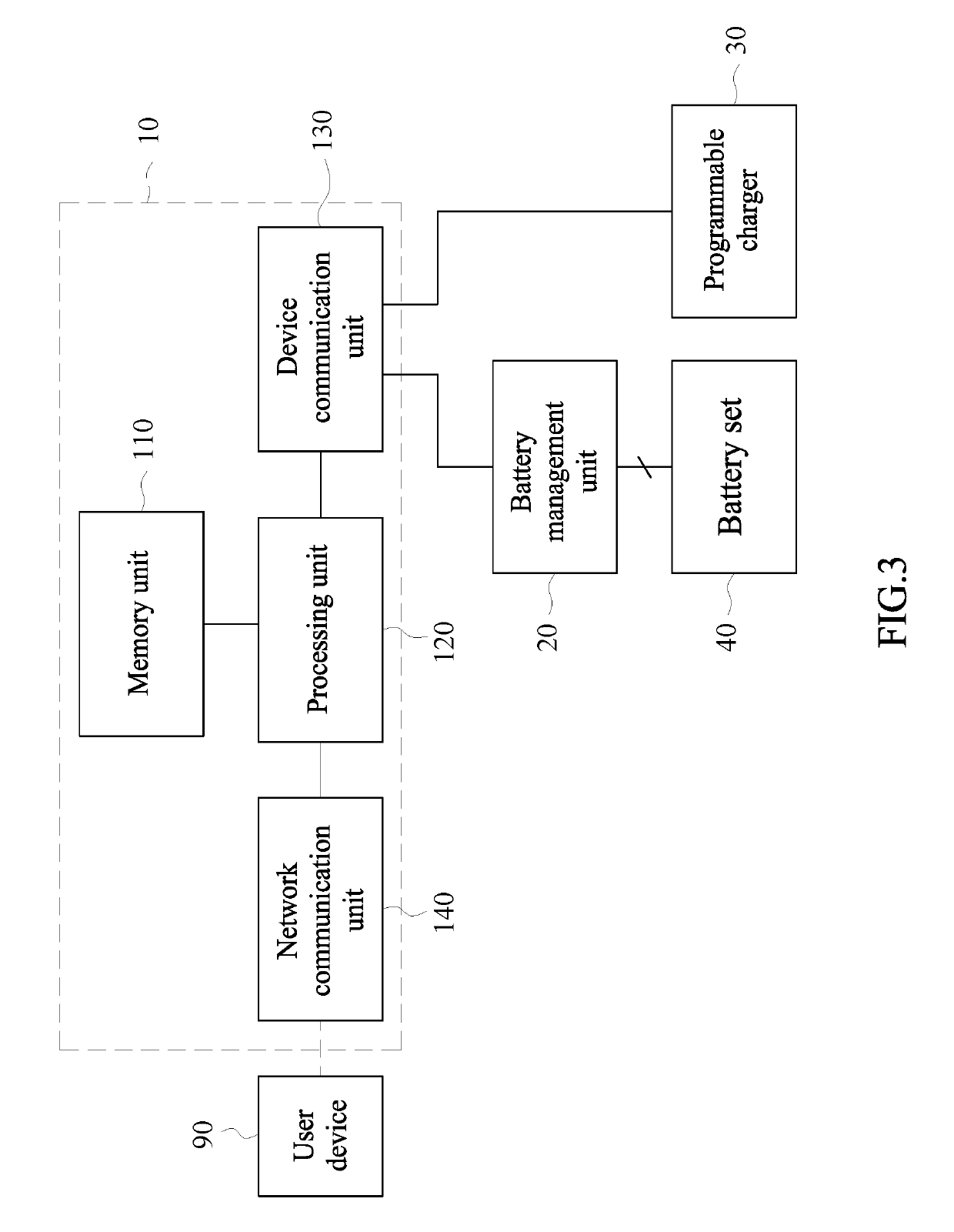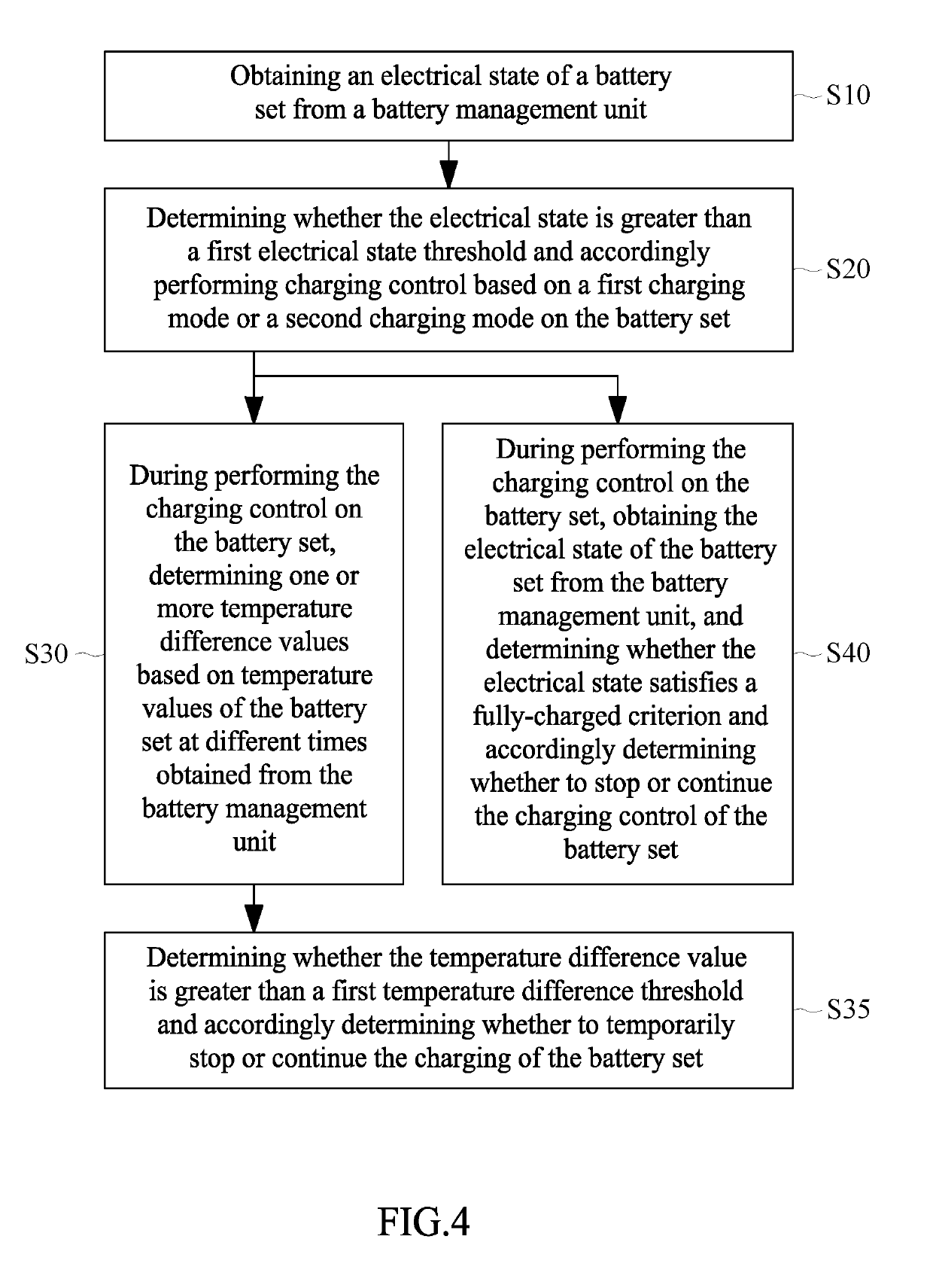Charging control apparatus, charging control method and computer readable medium thereof
- Summary
- Abstract
- Description
- Claims
- Application Information
AI Technical Summary
Benefits of technology
Problems solved by technology
Method used
Image
Examples
example 1
[0061]In example 1, a test is conducted for determination of charging parameters, wherein a maximum output current of 60 A (i.e., 1 C) is set for the test. The charging parameters for a five-stage charging mode are: 54 A (0.9 C), 49.5 A (0.825 C), 39 A (0.65 C), 31.5 A (0.525 C), 25.5 A (0.425 C); and a trickle charging parameter is: 9 A (0.15 C), wherein the corresponding charging currents decrease successively or in a stepwise manner and a voltage of 460V is set. Referring to FIG. 7, a diagram of battery temperature with respect to time illustrates both tests respectively according to charging control as indicated in block S20 of FIG. 4 (curve C11), and a constant current charging method (curve C12).
example 2
[0062]In example 2, a test is conducted for determination of charging parameters, wherein a maximum output current of 100 A (i.e., 1 C) is set for the test. The charging parameters for a five-stage charging mode are: 90 A (0.9 C), 82.5 A (0.825 C), 65 A (0.65 C), 52.5 A (0.525 C), 42.5 A (0.425 C); and a trickle charging parameter is: 15 A (0.15 C), wherein a voltage of 460V is set. Referring to FIGS. 8A and 8B, FIG. 8A is a diagram of battery temperature with respect to time, illustrating both tests respectively according to charging control as indicated in block S20 of FIG. 4 (curve C21), and a constant current charging method (curve C22), and FIG. 8B is a diagram of battery voltage with respect to time, illustrating both an example according to charging control as indicated in block S20 of FIG. 4 (curve C31), and a constant current charging method (curve C32).
example 3
[0063]In example 3, a test is conducted for determination of charging parameters, wherein a maximum output current of 100 A (i.e., 1 C) is set for the test. The charging parameters for a five-stage charging mode are: 90 A (0.9 C), 82.5 A (0.825 C), 60 A (0.60 C), 52.5 A (0.525 C), 42.5 A (0.425 C); and a trickle charging parameter is: 15 A (0.15 C), wherein a voltage of 460V is set. Referring to FIGS. 9A and 9B, FIG. 9A is a diagram of battery temperature with respect to time, illustrating both tests respectively according to charging control as indicated in block S20 of FIG. 4 (curve C41), and a constant current charging method (curve C42), and FIG. 9B is a diagram of battery voltage with respect to time, illustrating both tests respectively according to charging control as indicated in block S20 of FIG. 4 (curve C51), and a constant current charging method (curve C51).
[0064]As can be observed from FIGS. 7 and 9A, during the charging of a battery set by the constant current chargin...
PUM
 Login to View More
Login to View More Abstract
Description
Claims
Application Information
 Login to View More
Login to View More - R&D
- Intellectual Property
- Life Sciences
- Materials
- Tech Scout
- Unparalleled Data Quality
- Higher Quality Content
- 60% Fewer Hallucinations
Browse by: Latest US Patents, China's latest patents, Technical Efficacy Thesaurus, Application Domain, Technology Topic, Popular Technical Reports.
© 2025 PatSnap. All rights reserved.Legal|Privacy policy|Modern Slavery Act Transparency Statement|Sitemap|About US| Contact US: help@patsnap.com



